|

Infectious Rhythms
Jim Lueers' 'Come to the Well',
enjoyed by KELLY FERJUTZ
The Church has always been a fixture in the community. Bigger communities led to bigger churches while smaller churches serve smaller populations. These days, churches spread out into larger areas, encompassing not only larger geographical areas, but also various means of ministering to their different constituencies.
In 1994, Pittsburgh church organist Jim Lueers saw a performance of Into the Woods that literally took over his life. He was so intrigued by the idea of mixing up all the fairy tales, that it made him wonder about doing that with biblical stories. And in the process, why not make it a play that would be suitable for the Christmas Holiday? Oh, wait! Why not add music? He was, after all, a gifted musician, especially active in church music, having earned his degree in organ and church music from Indiana University in Bloomington.
For the last two years he's been at Memorial Park Church in Allison Park, Pennsylvania, where his title declares him to be Minister of Worship and Arts. This includes all the music programming, dance, worship, a contemporary Saturday evening service, plus three regular services on Sundays. Oh, yes, and there's also an art gallery, with a new exhibit mounted every six weeks. Plus, there is the occasional drama presentation 'whenever one is needed,' he adds with a laugh. For the worship services, Jim will even sometimes be found at the keyboard of the Allan organ.
Well, anyway, that night at the Stephen Sondheim musical, thoughts bombarded Jim from all directions. It could take place in a garden, or maybe a well. There could be a wide variety of people in the area, especially if it was set just outside Bethlehem. For Christmas that year (he had previously done something different every year) 'the script just came together in about a week,' he says. 'There was a woman at the well, and a tax collector, and the Christmas story.' But when he started composing the music, it changed a bit.
'It has a simple set, making it easy for a church production,' he says. At that time, he was at Pleasant Hills Presbyterian in South Hills (the opposite end of Pittsburgh from where he is now). 'It was primarily a religious type of production, utilizing the middle school music and drama group, and we did it for two years -- 1994 and 1995.' He then went on to other things.
Originally, the accompaniment was for piano or organ. Then, he stepped it up a notch to four winds, five brass, keyboards and percussion. This year, however, he's taken it farther by adding in four violins. He did all the composition and orchestration himself. Of course, he also wrote the book and the lyrics. And this year he's also the director, so it really is very much a one-man production. Not counting the twelve or so singing actors who play all the main or speaking/singing parts. And the choruses: one of adults, one of children, plus the angel dancers. And the orchestra. Not quite a cast of thousands as in the early biblical-themed films, but a huge presentation by any standard, unless you're the Metropolitan Opera.
The well in question here is just outside the city limits of Bethlehem, and it is a community gathering place. A busy gathering place. At some point or other, all the main characters visit the well, in daytime or evening. They meet, befriend each other, separate and go forth on their separate journeys. The Book of Samuel in the old testament tells of King David longing to go back to a well near Bethlehem. It is, in fact, this well that is the centerpiece of the story. Once Lueers realized that, it all came together very nicely.
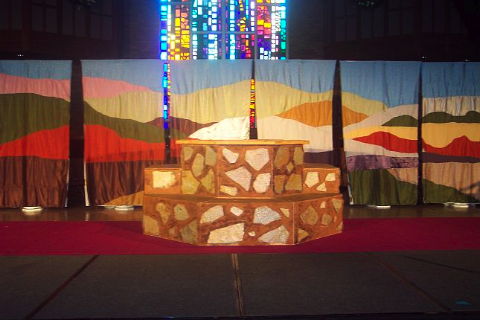
The well and banners
|
The large well was placed in the middle of the stage-like area, with six good sized banners on poles behind it. These were a sort of quilt-like illustration of the scenic landscape just outside the town walls, with clouds and pastures and blue sky, along with mountains in the background. Just before the final number of each act, these banners were lifted out of their standards, and paraded around and down the center aisle, in beautiful pageantry. But, also, it unveiled the orchestra and chorus (and cast members) ranged along the rear wall beneath the huge stained glass window, for the final number. The first act ended with Dance of the Angels and the second with the entire cast and the song Immanuel.
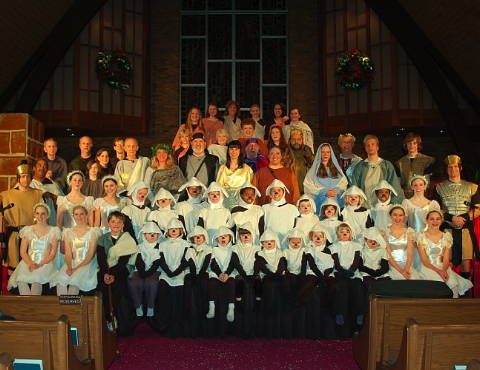
The 'Come to the Well' cast
|
This production benefitted greatly by marvelous casting. Mary (Sarah Morris) and Joseph (Andrew Boag) were indeed a young couple, struggling with her pregnancy as well as reporting for the census. At one point, they sang two very different songs simultaneously, which worked very well harmonically. Then they danced together to a ländler rhythm, which pointed out their comparative youth, and if not in love with each other yet, they were well on the way. Even if Joseph didn't quite believe what the Angel had told him.
Another duet, by the widow (Julie Kerr, who sang Hope is Born Anew) and her daughter Miriam (Alyssa Hensel with I Want to Believe) was gorgeous, each proclaiming their greatest wish -- to be reunited with each other along with their faith.
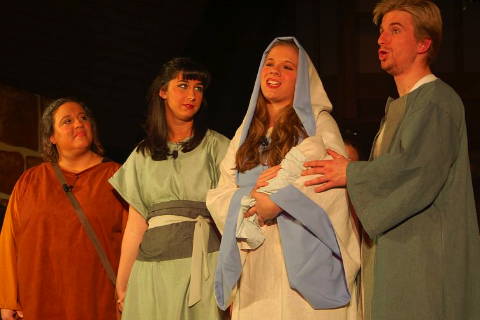
Julie Kerr as the widow, Alyssa Hensel as Miriam, Sarah Morris as Mary (with baby) and Andrew Boag as Joseph
|
There really was something for everyone here: lyrical songs, spoken words (to help further the action a bit), patter songs from the two kings, Bortez (Henry St George Tucker) and Diadech (Tom Mirth), and the thief (Roland Bowen), outlandish comedy routines (from Marcus Angelus, the tax-collector, performed by Curt Powell à la Vaudeville!), dancing, a touch of violence, and the hope of redemption for anyone.
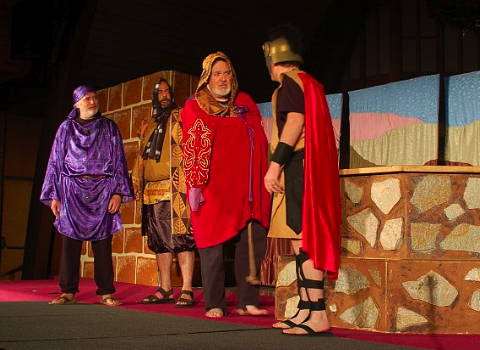
Henry St George Tucker as Bortez, Tom Mirth as Diadech, Roland Bowen as the thief and Chris Delposen as the centurion
|
Not everything worked as intended, but then that happens in the greatest concert halls too. Using mostly church members, the vocal abilities varied, as one might expect. Several local singers also joined the cast, ranging from the seventeen-year-old Alyssa Hensel (Miriam) to several professionals (or now retired). A couple of the songs were at the extremes of the designated vocal range, and might have fared better in another key, or by a change of octaves. Many of the younger singers were miked and unfortunately this didn't always work for the best. But these are entirely minor quibbles, and would in no way interfere with one's enjoyment of the overall production.
There were infectious rhythms, especially in the gospel rendition of Abraham, Won't You Come. Baritone Ike Readie did a great job, accompanied by primitive percussion of broom, a walking stick and a laundry basket, complete with shaker. The stick thumped the floor to keep the rhythm, while the other, larger one, rattled as it scraped the basket. It was exceedingly clever and drew a very loud and well-deserved ovation from the full house. Lueers commented afterwards, 'From the reaction of people it really worked and the stark accompaniment really added to that feeling. It was a new song I added just for Ike and it ended up being many people's favorite. So I've joked that next time I'll just orchestrate for broom and wash basket!' (The simple verses asked Abraham to come and lead us through pain, the Prophets to lead us past lies, Moses to lead us through fear and the Messiah to save us from sin.)
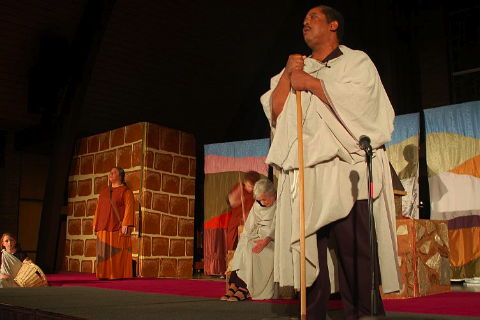
Ike Readie, a member of the Townspeople Chorus
|
In order to encompass as many of the parishioners as possible, twenty of the littlest members (age two to ten or so) were dressed as sheep, tended by a shepherd (Alan Coulter) and his wife (Terri Morris). Several slightly-older young ladies danced as angels. The two centurions, who escorted us in and out of the sanctuary and then did their thing on stage, were Chris Delposen and Bryan Henshaw.
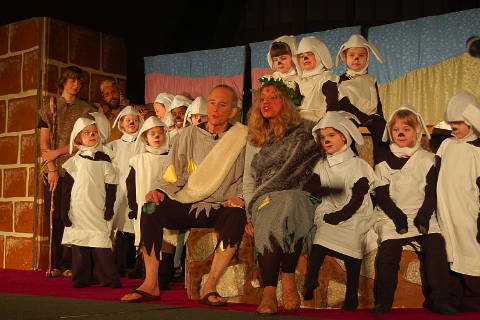
The Shepherd (Alan Coulter) and his wife (Terri Morris) with junior shepherds and sheep
|
The simple but effective scenic design was by Tom Anewalt, Tom Brunger and Geoff Holmes, while the banners were designed by Bonnie Readie. The fabulous costumes, designed by Kathy Pascoe, were bright, colorful and entirely appropriate.
Come to the Well combined several characters from the biblical rendition of the tax collections in Bethlehem at the time when Mary and Joseph were there, which coincided with the birth of their baby. It was not entirely historically accurate, but it didn't stray too far away from the age-old tales, either. All the stories and the characters were treated with respect, and both the spoken words and the songs furthered the story.
It would be an entirely suitable production for any community theater or church group to consider. It's not simple, nor is it grand opera, but it could easily be scaled up or down to match the availability of casting.
Copyright © 26 December 2008
Kelly Ferjutz, Cleveland USA

|

